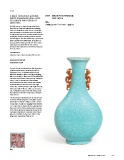Page 387 - Sotheby's October 3 2017 Chinese Art
P. 387
3716
A RARE TURQUOISE-GROUND 清乾隆 松綠地堆白料穿蓮夔龍紋轎瓶
WHITE-ENAMELLED WALL VASE 《乾隆年製》款
SEAL MARK AND PERIOD OF
QIANLONG 來源:
巴黎蘇富比2011年12月15日,編號175
the flattened pear-shaped body rising from a
short foot to a waisted cylindrical neck flaring
at the rim, flanked by a pair of iron-red and gilt
phoenix handles in openwork, the front painted
in a white slip with a pair of addorsed kui dragons
clambering amongst scrolling lotuses, above a
band of lappets, the rim encircled by a spearhead
border and the foot with keyfret, all against an
opaque pale turquoise ground save for a square
at the base inscribed with an iron-red four-
character seal mark, the rim and the footring gilt
20.6 cm, 8⅛ in.
PROVENANCE
Sotheby’s Paris, 15th December 2011, lot 175.
HK$ 450,000-550,000
US$ 58,000-70,500
It is rare to find the delicate lace-like decoration
of white enamel over a turquoise ground on
Qianlong vessels. A shallow bowl decorated
with bats amongst a lotus scroll, in the Nanjing
Museum, Nanjing, is illustrated in The Official Kiln
Porcelain of the Chinese Qing Dynasty, Shanghai,
2003, p. 265; a double vase, adorned with
shou characters and lotus scrolls and similarly
inscribed with four-character iron-red reign
marks, was sold in our rooms, 8th April 2013, lot
3031; and a tall ovoid vase, with a six-character
iron-red Qianlong reign mark and of the period,
was offered at Christie’s Hong Kong, 29th April
2002, lot 671.
The innovation of wall vases can be traced back
to at least the Ming dynasty. They were used to
hold flowers in indoor settings as well as inside
sedan chairs. A wall vase hanging on the interior
of a sedan chair is depicted in the painting An Ice
Game by Jin Kun, Cheng Zhidao and Fu Longan,
in the Palace Museum, Beijing, illustrated in The
Complete Collection of Treasures of the Palace
Museum. Paintings by the Court Artists of the
Qing Court, Hong Kong, 1996, pl. 61.
Mark
IMPORTANT CHINESE ART 385

